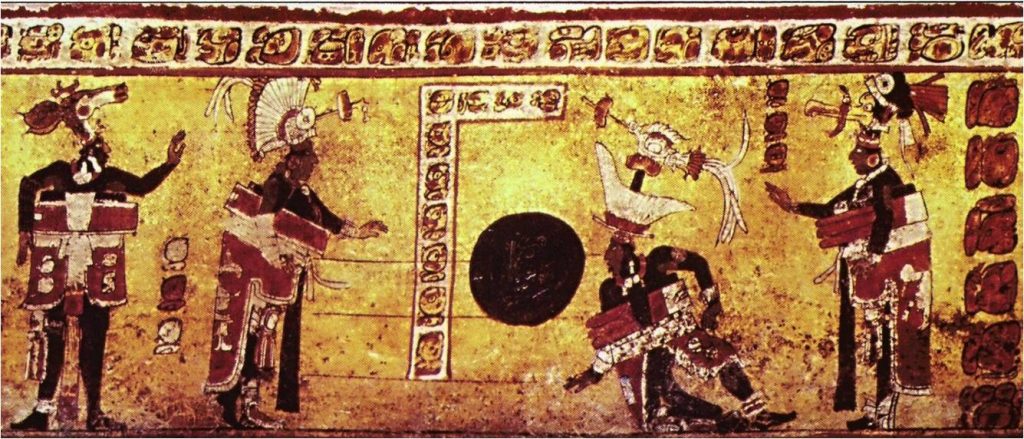El juego de pelota, dating back to 1500 BCE, is known as the oldest ball game ever created in human history. It was played across many Mesoamerican civilizations and recognized as one of the most solemn events of that time. The game held religious, social, political, and ritualistic significance unlike any other. This sport was more than just a game, but quite frankly, it was an event that often resulted in life or death.
The origins of this game are not precisely known, but many historians believe its first appearance to have derived from the Olmec society, the first major civilization in Mesoamerica.1 The Olmecs, who inhabited the gulf coast of Veracruz, were recognized for their development of latex in the pre-classical era. In fact, many game balls consisting of latex have been recovered from the region and have led historians to believe this evidence to be the origins of this great, ancient game. As millennia have gone by, several different Mesoamerican civilizations have adopted this sport and created their own unique styles of play. However, the general idea of the game was never changed.
The ball game consisted of two teams, ranging between two to four players. The players would wear protective garments and sometimes dress up in representations of an animal. Depending on the situation and culture, players would compete on uniquely structured ball courts. On game-day all members of the society would gather around with excitement for the big match up. Unfortunately, this was no light matter, and nothing close to our typical spectator-sports.2
There has been approximately thirteen-hundred courts discovered, from the state of Arizona to the southern most parts of Paraguay. These courts were comprised of a large, flat field with two walls on each side. Typically, these walls would be slanted. However, with many different cultures, these ball courts were not all the same across the geographic regions. However, they all had one thing in common: a ring mounted on the wall (whether it was flat or slanted). This large stone ring (on both sides), standing high and tall on the wall, would be the area where the players would aim to score. The goal of the team was to hit the rubber ball, without using their hands, into the mounted ring. In order to hit the ball, they would propel their bodies and fling their hips. This difficult motion made the game a challenge, and it was only capable of being played by a select few of each society.3

Unlike any other game, it was made up of tactical movements rarely seen in today’s professional sports. Players risked severe injuries by throwing there bodies across the stone court. In addition, the impact of the rubber ball could cause horrible bruising, often leading to internal bleeding, and possibly even death. If the game did not kill the player, the outcome certainly could. Due to the game’s religious nature, players who lost the match would often be sacrificed to the gods and killed in a ceremonial event.4
This game was a big influence across societies in Mesoamerica. It was not only a sport, but a highly regarded event. The Mayans considered it an opening to the underworld and intertwined the sport with mythological significance. The cost of losing would conclude in a sacrificial act; in this way, members of the society were able to keep their gods happy and ultimately balanced. As time went by, when the Aztecs adopted the game, it was seen as a problem solver. Players would compete on the stone courts, fighting for hierarchy and dominance. This formal competition would also lead to solving political conflicts. It was a great act of gamble, and certainly one with great significance.5
No matter the society, this game left a most distinctive resonance. It endured through many civilizations as the centuries went by, and created a sport with rich meaning. Whether through the symbolism of mythological gods or simply for the sake of competition, this ball game left details and stories of the once great civilizations of Mesoamerica. Although today’s evidence is limited, the message given across these magnificent stone courts is clearly shown.
- Jeffrey P. Blomster, “Early Evidence of the Ballgame in Oaxaca, Mexico,” Proceedings of the National Academy of Sciences of the United States of America 109, no. 21 (2012): 8020–25. ↵
- Salem Press Encyclopedia, January 2015, s.v. “Mesoamerican Ball Game,” by David A. Crain. ↵
- Colleen P. Popson, “Extreme Sport,” Archaeology 56, no. 4 (October 9, 2003): 42–48. ↵
- Zaccagnini Jessica, “Maya Ritual and Myth: Human Sacrifice in the Context of the Ballgame and the Relationship to the Popol Vuh” (Honors Thesis, Southern Illinois University Carbondale, 2003), 2-11. ↵
- World History Encyclopedia, 2011, s.v. “Mesoamerican Ball Courts – Fusing Game and Religion,” by Alfred J. Andrea and Carolyn Neel. ↵



70 comments
Noah Laing
I really wonder if the audience was somehow charged to watch the game, because it’d be extremely entertaining. In the article it states that all members of society would come to watch and I’d image that the crowd would be extremely hostile because the outcome of the “game” was so great. Before reading this article, I had no idea this was a game and I’d be very interested in reading more articles of the same content, great read.
Michelle Falcon
This past summer I was fortunate enough to go on a cruse with my family, One of the stopes we made while on the cruse was to Cancun where we were able to go and see the ball courts, at Chichen Itza. It was an amazing experience that I will never for get and after reading this article I feel like I have a better understanding for the sport.
Brianda Gomez
In history, we have talked about all the civilizations around the world. How they went from hunters to gatherers throughout the years. I really enjoyed reading this article because it took us to the “fun” part of Mesoamerican Civilizations. Today we have many different famous sports, but none end in a life or death situation. It is incredible the amount of significance the game meant to these people; it was an “opening to the underworld” and the loser of the game would have to be a part of a sacrificial act. Great article!
Andrea Chavez
This is a very good topic; actually this is a topic I wanted to talk about. I like that your article gives a general idea of it all in a very clear manner. But there is something you said in the article that caught my attention. When you talked about religious purposes, you mentioned that the losing party had to be sacrifice. If I don’t recall wrong, the winning team was the one being sacrificed since they were the ones worth sacrificing to the Gods. Which was a great honor for the team.
Alexis Renteria
To be completely honest, I had never heard of this game before, and I think its insane the game is played. To use only your hips to make the ball into the ring sounds nearly impossible, and it makes me wonder how long these games usually lasted or if they instituted a rule where if they ran out of time they would settle it another way. Overall, this was a very interesting article and I’m glad that I know now were sports could have come from.
Samman Tyata
Honestly, I had never heard about this game. I really liked the way how you have provided detailed information. It’s really amazing that the competitors are successfully able to score only using their hips. Also, players competing on the stone courts, fighting for hierarchy and dominance is something I had never heard of and that’s really amazing. The fact that it was even seen as a way to settle political disputes is just mind-boggling to me. To sum it up, I really liked this article.
Matthew Rios
I remember hearing of this game once before, but had no idea people were sacrificed for a loss, nor did I know they had to use their hips to make the ball into the ring. Not sure how anyone would win quite frankly, this game sounds impossible. How does country the angle of attack in any realistic way. Besides the fact people are scarified for losing, this was fun learning experience and good article.
Eduardo Foster
It’s interesting the way Mesoamerican civilizations take the risk of playing the game knowing the consequences. It’s crazy how they could play knowing that at the end one will be sacrifice! By other part is admirable the strength and ability these players had, it should have been tough! I also admire how serious they take their religious affiliations.
Jennifer Pogue
Great article! It was informative and a fun read. I am glad we don’t play games like this anymore! I would love to see the ball courts. I like to watch sports, so it would be interesting to see a reenactment of the game (without the sacrifice). They must have trained hard and been very athletic to jump that high to be able to get their hip to hit the ball in the circle. I can’t imagine trying to do that myself. Overall, great article!
Lianna Ybarra
This game must have been so crazy to watch! I wonder if these people knew that when they would propel their bodies to the rubber ball that they were hurting themselves internally. Thinking about it, this sport kind of reminds me of soccer. They couldn’t touch the ball with their hands but had to aim it in the goal. I wonder if different forms of this were passed down and this is where the idea came from. Overall, I thought this was a great article!